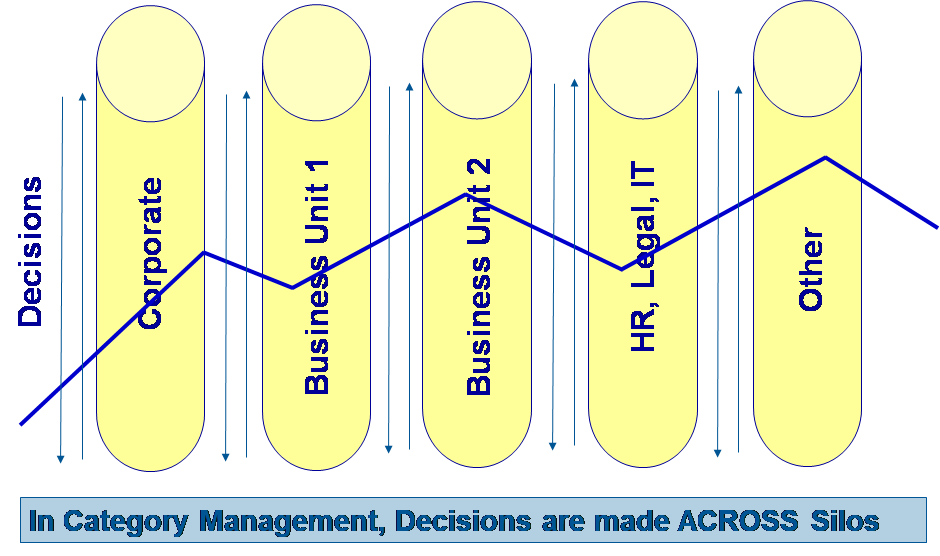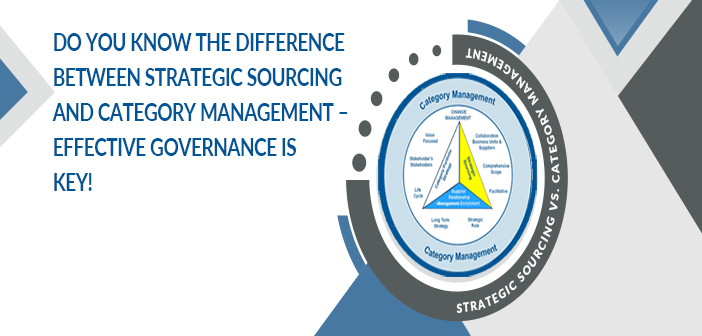There’s that word “governance” and personally it makes me cringe. It reminds me of what we are bombarded with in the news every day – chaos, partisanism, division, in-fighting, etc. (all very negative) but Governance can be positive and effective and is THE BEST way to get decisions made collaboratively in Category Management. Here are some of the major issues and challenges our clients have encountered at they move from Strategic Sourcing to Category Management:
- Business Units and Corporate Departments opt to not participate in Category Management (impacts leverage)
- Numerous Suppliers identified as “Sacred Cows” (leverage)
- Resources are not available when needed from BUs
- Misalignment on Roles / Accountability (Category Management vs. BU vs. SRM)
- Category Management process is not adopted across entire organization
- BUs want to maintain the status quo
- BU Value Drivers NOT understood (significant resistance)
- Timelines and Deadlines are missed – Savings and Benefits are not realized
- Decisions need to be made across BUs not within silos which is not typical

This conundrum is why Governance is SO important. We have written about Governance before because it is so critical to your journey from Strategic Sourcing to Category Management. The purpose of Governance is to ensure:
- Participation by key stakeholders in decision making – better / faster
- A forum to hold all stakeholders accountable to each other
- Organizational barriers (silos) are removed
- Guidance is provided to the teams where needed
- Cross BU alignment / collaboration / adoption
- Representation of major stakeholder organizations
- Leveraging the FULL Buying power of the company – NO OPTING OUT
- Category Management’s Value is showcased – builds credibility
- Elimination of the biggest source of friction in Category Management – getting decisions made
And just like establishing a new government, Governance can be quite painful at the start. Our clients often resist the idea of Governance because they are concerned that it is an onerous process and they won’t be able to get senior leaders to participate. But most organizations already have governance bodies in place – here are a few examples:
- An Executive Council / Leadership Team (all C level executives are members) – they make / approve major decisions for the company. Isn’t selecting an ERP supplier or outsourcing a piece of the business a major decision?
- An IT Steering Committee (usually made up of senior BU heads) – they make decisions on major IT investments. IT is a shared service organization just like Procurement so a Category Management “Steering Committee” can play a similar role
These governance structures were most likely established for the same purpose that we recommend one for Category Management – to add speed and velocity to decision making and create buy-in to ensure ADOPTION. We often recommend that if you can tap into an existing structure, you should try to do so. But, in Category Management there is usually a tiered Governance structure that forces decisions to be made at the appropriate level. Here is what a tiered structure may look like:

We have clients that have as many as five Governance Groups and the lower level Groups (Level 5) can be just as effective and impactful as Level 1. Here is an example of decisions that would go to Level 1:
- Outsourcing certain internal functions
- Which BUs may or may not OPT out of Category Management
- Which geographies can suppliers come from (are emerging markets OK?)
- Which suppliers / relationships are exempt from examination
- How to handle customers that are also suppliers
This may sound VERY complicated, but it is not. Our clients that have taken the time to put in Governance to support their Category Management teams will tell you that they would not be successful without it. If the thought of “governance” makes you cringe, then think again because Category Management cannot be done without it!
Join in the conversation and let us know what you think . . . . .

